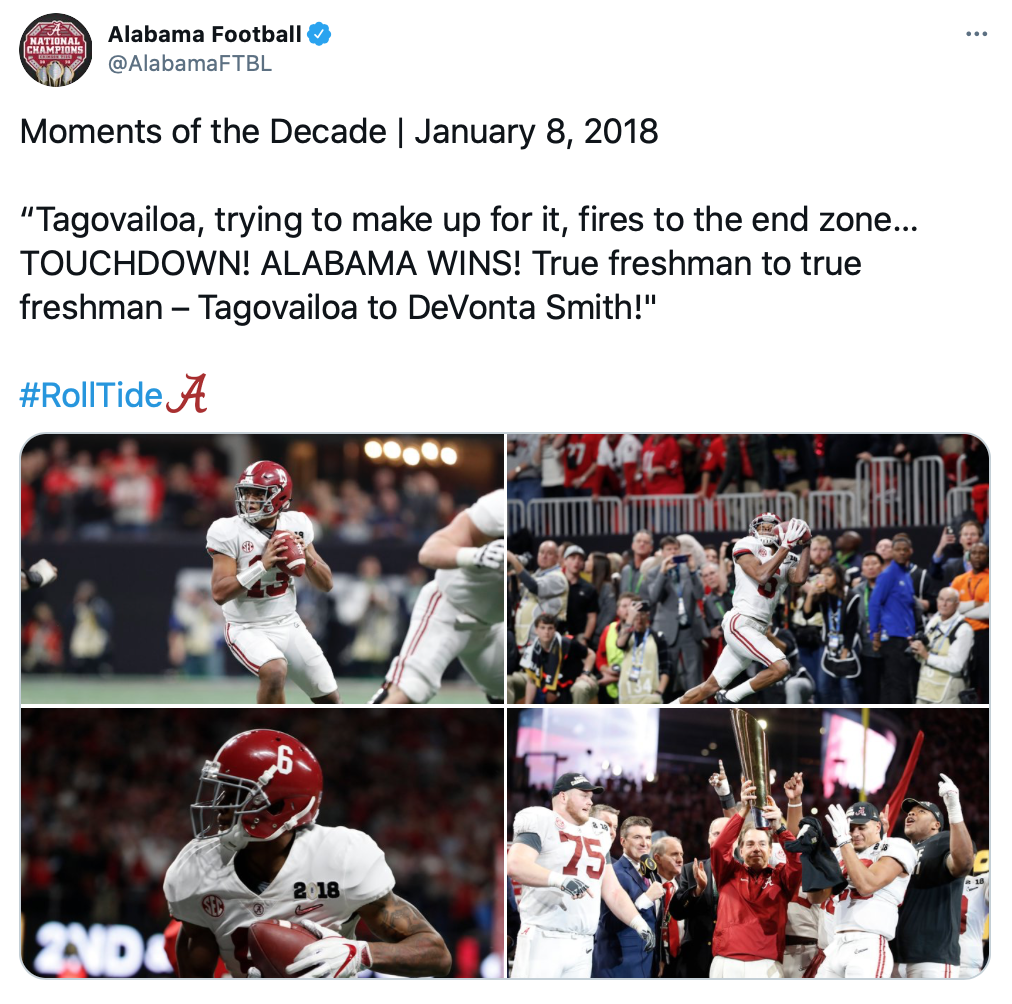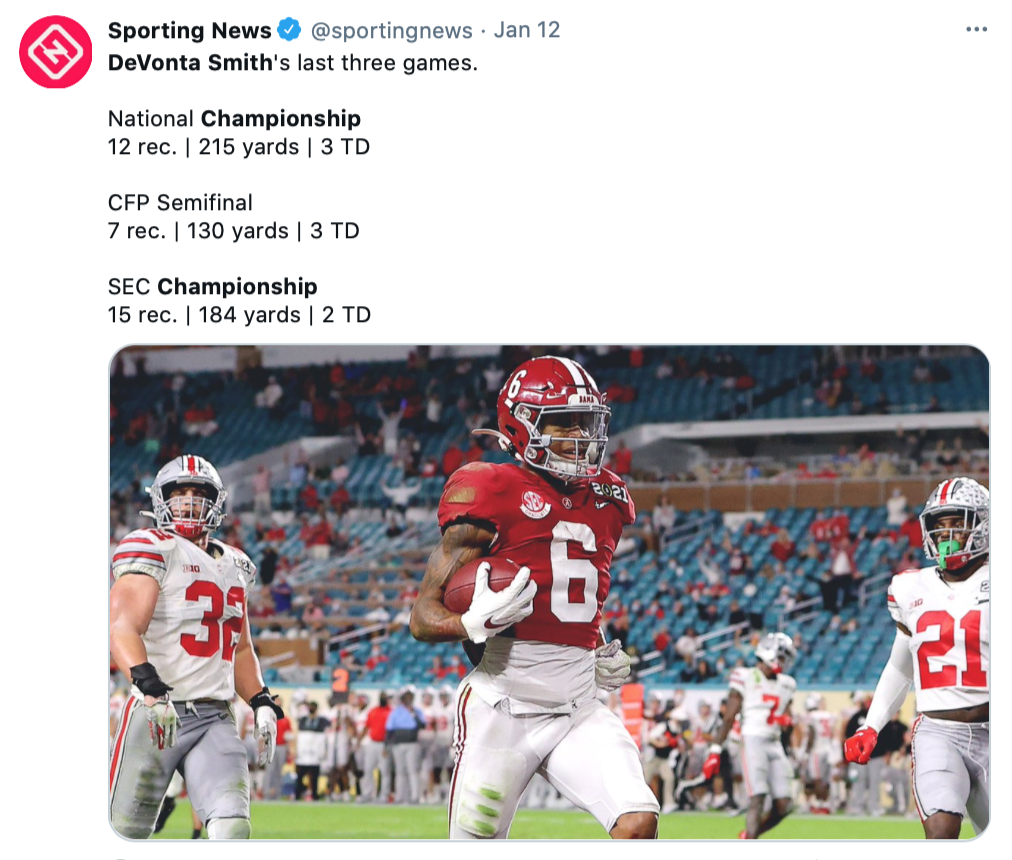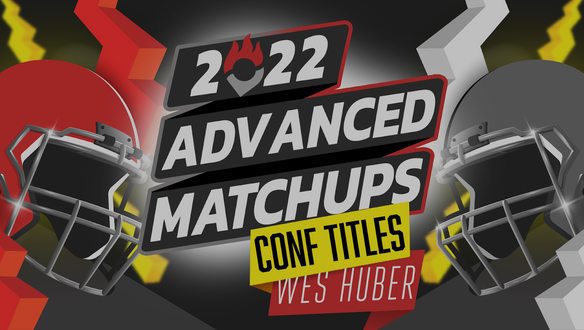DeVonta Smith
WR | Alabama Crimson Tide | 6-1 | 175 lbs.
The Story
I, for one, was unprepared for the rise of DeVonta Smith this season. First of all, he would be sharing the premium targets with Jaylen Waddle. Another share of the load would also be distributed to rising super-soph John Metchie III. However, after Waddle suffered a horrific ankle injury in Week 7 against Georgia, the stage was set for Smith’s ascension to Heisman stardom. The absence of Waddle is certainly not an attempt at stating that Smith simply “volumed” his way toward the top. It simply opened the curtains for the rest of us to see just how special the true senior out of Louisiana could be within the featured role in the passing offense.
I shouldn’t insinuate that Smith came out of nowhere before the 2020 season, of course. He provided the Tide with 14 receiving TDs and 1,311 yards during his true junior season (while playing alongside first-round picks Jerry Jeudy and Henry Ruggs). But Smith displayed improvements in efficiency that dwarfed the impact of any additional volume. Judging by the metrics during the entirety of his Alabama career, Smith’s yardage per route efficiency out of the slot was 28% higher than when split wide. With that in mind, it’s not that surprising to learn that his slot involvement increased by 19% during his Heisman season following the injury to Waddle.
Taking a step back to look at Smith’s big picture, his pre-college career was defined by uncertainty. Coming out of Amite City, Louisiana, he played for his hometown high school of the same name. However, even though he led the Warriors in capturing the 2016 LHSAA Class 3A state championship, his school still ended up ranking outside of the top 1,350 teams nationally. The perception of watered-down competition led to his evaluations falling all over the spectrum. Rivals listed Smith as the sixth-best WR in the 2017 class, ESPN ranked him 34th, Scout had him third, and 247Composite placed him ninth.
The Attributes
The fact that Smith ran a verified 4.49 40 time at the ‘17 Nike Opening at 6-foot, 157 pounds didn’t help matters. Smith has since added nearly 20 pounds to his frame, and we’ve seen a list of dedicated athletes improve those times by the end of their college careers. But Smith certainly didn’t allow any doubts in his abilities to affect his play, making a name for himself in his very first season with Bama. On 2nd-and-26 in overtime of the 2017 National Championship game against Georgia, Smith blazed a trail through the Bulldogs’ Cover 6 shell to burn safety Dominick Sanders for the walk-off TD.
It’s difficult to imagine ways that Smith could top that high toward aiding the program. But the success was far from complete. Even when he was competing for targets with Jerry Jeudy, Henry Ruggs III, and Waddle, Smith still compiled over 700 yards and six TDs his true sophomore season. He also posted a 6/104/1 line facing Oklahoma in the first round of their 45-34 playoff victory. Smith would garner a 45 percent target share during that playoff run, leading the team with 17 receptions.
DeVonta would then finish his true junior season with over 1,300 receiving yards and 14 TDs. He earned recognition as a Biletnikoff Award semifinalist, and was named to the All-American Second Team. A pair of 200-plus yard games that season facing Ole Miss and LSU provided the evidence for what was to come next. An average line of 10/126/1 or 28.6 FPG over his first four ‘20 games was pretty damn good. But, following the injury to Waddle, Smith would average 8.8/152.6/2.1, or 36.7 FPG, over the final nine games. Keep in mind, Smith and several other starters took a backseat to the defense during their Week 15, 52-3 destruction of Arkansas. Removing that result, Smith’s average line was 9.5/169/2.1 or 39.1 FPG.
No other results were more important than during the playoffs. Facing Notre Dame’s stifling run defense in the ‘21 Rose Bowl, Smith was once again the focal point of the nation's top offensive attack. I love this quick highlight reel of Smith’s game provided by RSHighlights. On the very first play, you can get a sense of just how quick Smith is in the open field facing the Fighting Irish in man coverage. A quick strike to the flat, two silky smooth cuts are all Smith requires to find paydirt. Skip ahead in the video to 27 seconds, another bubble screen, and another example proving that 4.4-speed is 4.4-speed no matter how densely packed the receiver.
At 35 seconds, a play UND nickelback Nick McCloud and strong safety Shaun Crawford would surely like to forget, Smith torches the pair in Cover 1 on a simple RPO slant for a 34-yard TD. Moving to 1:13 in the video, we see the Irish attempting to mask Cover 4 with Crawford lingering underneath. Even when Mac Jones’ throw is affected by Adetokunbo Ogundeji, Smith towers over Temitope Agoro for a 21-yard gain. At the 1:35 mark, we have ]what I feel is an example of the premier sideline awareness in the class. McCloud is once again the victim, left on an island to man-up on Smith’s comeback route, who somehow manages to get both feet in bounds.
Let’s move on to the ‘21 National Championship against Ohio State. In the very first example, we see a routine bubble screen where partial blame for the result falls upon strong safety Josh Proctor for his over-pursuit to the inside. But true junior Sevyn Banks makes the colossal mistake of losing contain that results in a 22-yard gain on the second play from scrimmage. Crowned “Defensive Back U” by ESPN, the version of the Buckeyes’ roster that faced Alabama falls well short of the elite secondaries of the year's past. And the most important game for Banks is also the worst performance of his career.
Prior to the National Championship, Smith collected a combined line of 23/259/0 or 0.56 FPs/Route when facing Cover 3. For reference sake, Davante Adams averaged 0.52 FPs/Route when facing NFL Cover 3 this season. Far from a poor result from Smith, but also far from the video game numbers we see when he’s facing other coverage types. The ‘20-21 Ohio State defense played Cover 3 on over half of all snaps during the season. In the title game, Smith assembled a 6/120/1 line versus Cover 3 or 1.50 FPs/Route… in the first half alone.
Move to 0:40 seconds in the video for my first example of Smith vs. Cover 3. Banks is responsible for the boundary third of the field here. Rather than playing high-to-low, as is his obligation here, he releases Smith after 15 yards, and leaves him wide open for a 30-yard pickup. At the 1:45 mark, Banks is simply running off into no man’s land on this Ghost Flare to the left flat from Smith for a five-yard score. And it makes complete sense that the very next touch is another Ghost Flare to the right where Banks is, once again, humiliated by Smith’s change-of-direction mastery (COD). At 3:01 in the video, Smith is guarded in man by Shaun Wade, OSUs best coverage defender. Not a matchup Smith is unable to handle after he plucks this back-shoulder go out of the air, two feet down, for 16 yards.
Moving to the 3:24 mark, are we witness to another RPO Swing to the flat? Not this time. Smith sets Wade up on the fake screen, releasing into a slant for 14 yards. Another RPO, another example facing Wade in man coverage, and we also have an example of Smith opposed by a defender with a 40 time in the low 4.4s. Smith has zero trouble whatsoever blazing around the jam attempt for big separation on the 39-yard gain. The close-up view of the play at 3:48 really defines Smith’s wiggle at the line, circling in red the impending difficulty ahead for NFL CBs hoping to get hands on DeVonta.
At the 3:58 mark… another Ghost Flare, another embarrassing inside overpursuit from Banks, and another easy TD — “easy” in the fact that Smith opened a seven-yard wide lane to the end zone with his elite COD before the ball was even snapped. We’ll most definitely see Smith return punts for the team that drafts him, so the example at 4:43 showcases the fluidity of his movements, chaining together his, yet again, elite COD while eating up yardage. A simple, seemingly innocuous turn of the hips, and, with the aid of a block by Patrick Surtain Jr., Smith forces Chris Olave to lose primary contain.
Just in case we required further evidence in support of Smith’s lethality against a Cover 3 scheme, he masterfully isolates Tank Borland on an island thanks to free safety Marcus Williamson leaving his teammate out to dry without the expected support over the top. An endless chain of mistakes by the Buckeyes, endless examples of Smith outsmarting his adversaries at every turn to collect the second CFP National Championship of his Tide career.
Judging from the tape, I think that we’ll see Smith improve upon his pre-college 40 time. If not, his vertical measurement and three-cone time will hold added importance for his athletic profile.
Smith measured with a 34.5 vertical jump, right around the WR average, at the ‘17 Nike Opening. But I think Smith shreds with a three cone time well below four seconds. His COD ability could be the best in the class. He is so fast at sinking his hips in and out of routes that CBs attempting to mirror his core are forced to hold on for dear life before falling prey to his reliability at the catch point. No matter the official 40 time he records, I am already convinced of Smith's fluid stride allowing him to devour NFL yardage.
Fantasy Fit
Scrutiny in the NFL abounds for all who collect a Heisman Trophy. We can expect that level of surveillance to only be magnified when a wide receiver, Smith was only the fourth such example, takes home the prize. Pulling together his full body of work, I feel Smith will provide fantasy rosters with sideline awareness and footwork on par with a Calvin Ridley and Justin Jefferson.
The burning question of the offseason is whether we should consider Smith or Ja’Marr Chase with the first pick of rookie drafts, akin to the decision facing NFL teams dead set on adding the top WR in the class. Over the long run, I simply do not think either decision will prove to be incorrect. But I do feel that Chase will have the more immediate impact. He is essentially built like a RB with route-running prowess well beyond his years, and the vast majority of his production was earned on “NFL” routes.
I am also a tiny bit concerned with the current projections on Smith’s BMI (23.1). We have a good amount of historical data telling us to focus our fantasy attention toward WRs with BMIs in excess of 25. The data also states this is especially true for those low BMI WRs with 40 times in the 4.4s-or-higher. Under those guidelines, the most important measurement for Smith would end up being his weight. However, I am not entirely convinced of the BMI limitation when the WR in question could offer truly special attributes. These types of trends are built to be bucked. I still feel entirely comfortable stating that Smith should be considered as our WR2 in ‘21 rookie drafts, worthy of the third-overall pick behind Chase and Najee Harris. Unfortunately, we couldn’t get some answers to our questions on Smith at the Senior Bowl.
I want to be very careful with my player-to-player comp on Smith. While I am not fully buying into the BMI argument, I still feel it holds weight in comparison to another. Unless Smith is timed with a 40 in the 4.3s, comps to a Will Fuller, DeSean Jackson, or Robby Anderson are adventurous, likely foolhardy. Smith is a tad smaller, albeit with far better hands, so Anderson is a close, but still a sloppy comp. At the end of the day, I landed on a stylistic comparison with a young Marvin Jones Jr., with a bit higher ceiling. Similar expectations in height (6-foot-1.5), speed (4.46), COD (6.81), a match in hand reliability, and who I feel will follow a similar career arc in succeeding by Year 2. Were it not for the issues in size, I would fully fall in behind the far sexier comps floating around the industry. As for a landing spot, the Eagles, Lions, and Giants make varying levels of sense.
The Bottom Line
Don’t confuse the estimation to Jones as needing to drop DeVonta out of the top-five in rookie drafts. Smith has the ability to instantly gain separation to go along with outstanding hands. He is perfectly capable of outplaying anyone’s expectations to become a borderline WR1 in fantasy. However, he will need to hit the weight room with a zealous dedication in order to reach that level. It’s for that reason that he is clearly not in competition with Chase for the honor of WR1, and falls in much closer with Waddle competing to be the WR2 in rookie drafts. Obviously excluding superflex formats, I see Smith in the 3-5 range of the overall ‘21 class. But he possesses a collection of playmaking talents that should equate to a very long NFL career of eventual Pro Bowl-caliber production.












